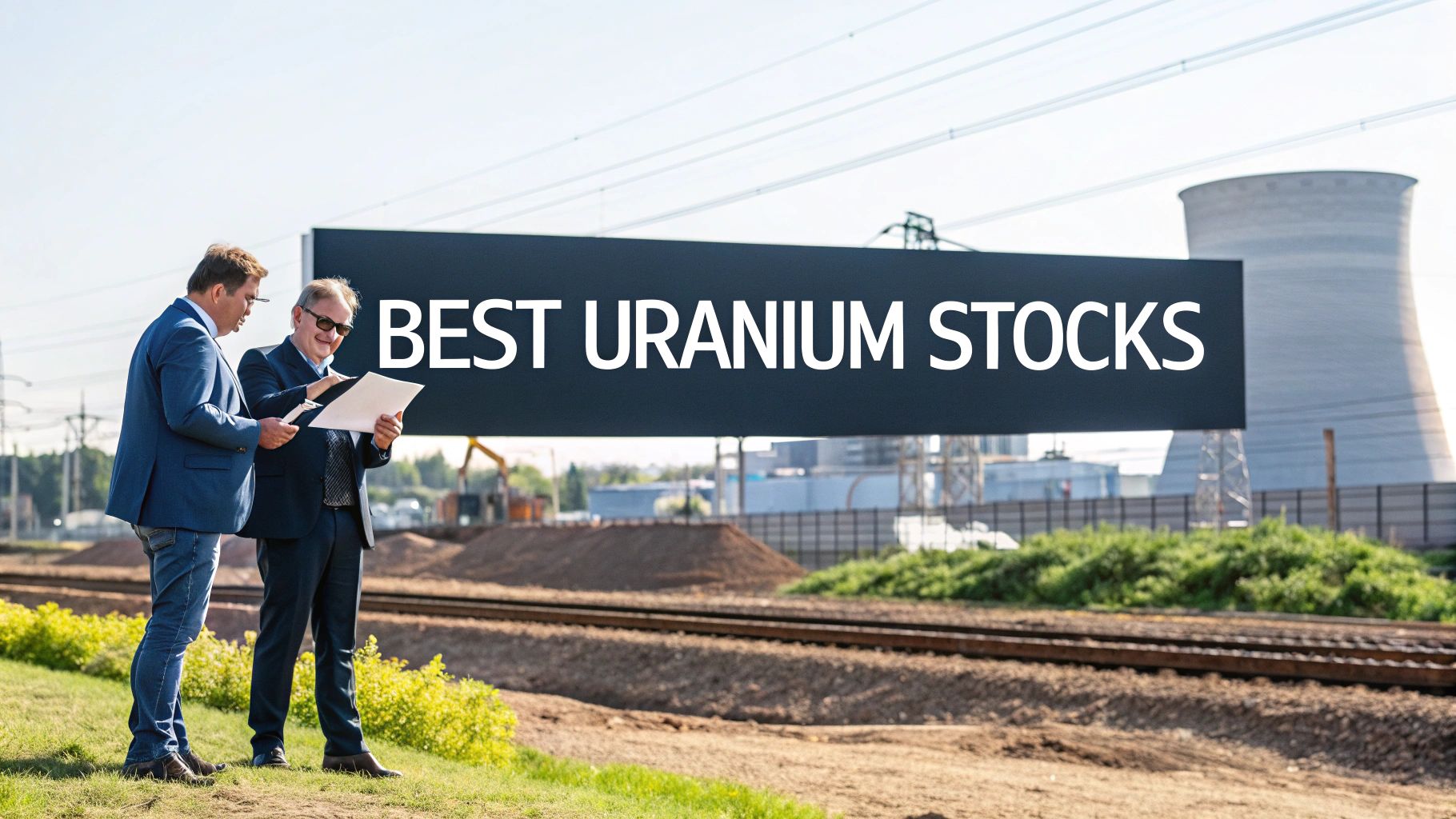Understanding Today's Uranium Market Landscape

The uranium market has caught fire recently, drawing intense interest from investors looking for new opportunities. The numbers tell a compelling story – U3O8 spot prices have jumped 275% over the past five years, far outpacing the broader commodities market's modest 32.54% gain. This dramatic rise stems from several key forces reshaping the market, from shifts in global energy policies to serious supply shortages.
Key Drivers of Uranium Market Growth
Three main factors are fueling uranium's strong performance and creating opportunities for investors:
-
Nuclear Power's Comeback: Countries worldwide are taking a fresh look at nuclear energy as they seek to reduce carbon emissions. This renewed embrace of nuclear power naturally drives up demand for uranium fuel, creating steady buying pressure in the market.
-
Global Energy Security: Recent geopolitical tensions have pushed many nations to reduce their reliance on imported fossil fuels. Nuclear power offers a path to energy independence, spurring new reactor projects that require uranium supplies.
-
Limited Supply: Getting new uranium mines up and running takes years, creating a bottleneck as demand rises. Recent mine closures and production challenges have further squeezed available supply. This supply-demand gap helps explain uranium's price strength.
Why Uranium Miners are Outperforming
Mining companies are seeing their profits soar as uranium prices climb higher. Here's what's driving their strong results:
-
Higher Sale Prices: With uranium prices hitting $95-100 per pound in some long-term contracts, miners are earning much better margins on every pound they produce. These improved economics flow directly to their bottom lines.
-
Growing Market Interest: As more investors recognize uranium's potential, they're putting money into mining stocks. This rising demand for shares provides price support and access to growth capital.
-
Future Outlook: Many analysts expect uranium prices to stay above $100 per pound, though recent swings between $106.75 and $77.08 show the market's volatility. While past results don't guarantee future gains, the long-term supply-demand picture appears favorable.
These market forces help explain why uranium stocks have done so well lately. For investors considering the sector, understanding these dynamics is crucial for evaluating specific mining companies. The next section examines what separates the top performers from the pack.
Analyzing Top-Performing Uranium Companies

While the uranium market offers clear investment potential, success requires looking beyond broad market trends to understand what makes certain companies stand out from their peers. Smart investors know that finding the best opportunities means carefully evaluating individual companies across multiple factors. Let's explore the key characteristics that set leading uranium companies apart and how to identify those with the strongest prospects for long-term growth.
Key Metrics for Evaluating Uranium Stocks
When analyzing uranium companies, experienced investors focus on several essential metrics that reveal a company's true potential. Just as you wouldn't buy a house without checking its foundation, examining these core aspects helps paint a complete picture of a company's strength and future prospects. Here are the critical factors to consider:
-
Production Capacity and Efficiency: A company's production capabilities directly impact its bottom line. Look for companies that can extract and process uranium cost-effectively – the lower their per-pound operating costs, the better positioned they are to profit even when prices fluctuate. For instance, companies using advanced extraction methods often have significantly lower production costs than those using older techniques.
-
Resource Quality and Reserves: Think of uranium deposits like real estate – location and quality matter enormously. Companies with large, high-grade deposits can produce more uranium at lower costs. This becomes especially important when prices rise, as these companies can increase production while maintaining healthy profit margins. The grade of uranium ore is particularly crucial – higher concentrations mean more efficient extraction and processing.
-
Management Team and Strategy: Success in uranium mining requires both technical expertise and business savvy. Look for leadership teams with solid track records in resource development and clear plans for growth. The best teams combine mining experience with financial acumen and can guide their companies through market ups and downs while maintaining a focus on long-term value creation.
-
Financial Health and Stability: Strong finances provide companies the flexibility to weather tough times and seize opportunities. Key indicators include healthy cash reserves, manageable debt levels, and consistent cash flow. Companies with solid balance sheets can fund new projects and maintain operations even during market downturns, positioning them for growth when conditions improve.
Case Studies: Examining Industry Leaders
To put these evaluation criteria into practice, let's look at Uranium Energy Corp (UEC) as an example. This company has earned attention for its growing project portfolio and significant market presence. When we apply our evaluation framework, we see how factors like operational efficiency and resource quality contribute to a company's potential.
For instance, UEC's management of production costs and the quality of their uranium deposits provides concrete examples of how these metrics play out in the real world. By studying companies like UEC and comparing them against our key metrics, investors can better understand what makes a uranium stock worth considering. This analytical approach helps identify companies that don't just look good on paper but have the fundamental strengths needed for long-term success in the uranium market.
Supply-Demand Dynamics Reshaping the Market
Understanding how supply and demand shape the uranium market is essential for making smart investment decisions. The market continues to change as new factors emerge, creating both risks and rewards for investors interested in uranium stocks.
The Demand Side: A Nuclear Renaissance
Nuclear power is gaining renewed attention as countries look for clean energy solutions. More nuclear reactors are being built and existing ones continue operating, driving up the need for uranium fuel. Some market experts believe this growing demand could push uranium prices to $95-$100 per pound. When evaluating uranium stocks, it's important to consider which companies are best positioned to supply this increasing market need.
The Supply Side: Constraints and Bottlenecks
Getting new uranium mines up and running takes significant time and effort. The process involves extensive exploration, strict permitting requirements, and years of development before production can begin. This creates natural limits on supply growth, especially when demand rises quickly. Political issues and mine closures can further restrict supply. These constraints help explain why uranium prices have been rising and highlight why investors should focus on companies with reliable supply sources.
The Impact on Uranium Stock Performance
The push and pull between supply and demand directly affects how uranium stocks perform. Companies that already produce uranium and have easy access to reserves tend to do better when prices go up. For example, producers with low operating costs can earn more profit as uranium prices increase. In contrast, companies facing production problems or lacking good uranium deposits may struggle. These basic market forces play a key role in picking promising uranium stocks.
Spot Prices vs. Long-Term Contracts
The uranium market has two main pricing mechanisms – spot prices for immediate delivery and long-term contracts. Spot prices often swing up and down based on short-term market conditions. Long-term contracts provide more stable pricing for both mining companies and nuclear power plants. Currently, some new long-term contracts are being signed at $95-$100 per pound, suggesting buyers expect prices to stay high. Companies that balance both spot sales and long-term contracts can benefit from quick market gains while maintaining steady future income. Understanding these pricing dynamics helps investors make more informed decisions in this evolving market.
Learning From Historical Market Cycles

Smart uranium investing requires looking beyond just current market conditions to understand the bigger picture of how this commodity moves in cycles over time. By studying past market behavior, investors can spot patterns that help guide their decisions about when to buy and sell uranium stocks. The uranium market has shown clear boom-and-bust patterns throughout its history, with prices and stock values rising and falling based on shifting supply and demand.
Identifying Key Phases in Uranium Cycles
Like other commodities, the uranium market moves through four main phases that tend to repeat over time. While the length and strength of each phase varies, understanding this pattern helps investors know what to expect and when to act.
-
Expansion Phase: During this time, demand picks up as more nuclear plants come online or restart operations. Mining companies can't increase production fast enough to meet growing needs, pushing uranium prices higher. This lifts uranium stocks across the board.
-
Peak Phase: Prices hit their highest points as demand stays strong. Many investors pile in during this exciting time, though risks start building. Mining companies rush to find new deposits and open mines to cash in on high prices.
-
Contraction Phase: Growth slows down or reverses, sometimes because of major events like nuclear accidents or policy changes. Too much new mining creates oversupply just as demand drops. Uranium prices fall and take stock values down with them.
-
Trough Phase: The market bottoms out with low prices everywhere. While challenging for the industry, this creates good buying chances for patient investors. Companies with healthy finances and efficient operations often do best at weathering these tough times.
Applying Historical Lessons to Current Market Conditions
Looking at past uranium cycles gives helpful context for today's market environment. By figuring out where we are in the current cycle, investors can make smarter guesses about future price moves and find better entry points. Of course, history doesn't perfectly predict the future.
Take the early 2000s uranium bull run as an example. Strong demand growth combined with tight supplies sent prices soaring. This sparked a wave of new mining projects that eventually flooded the market, leading to a big price drop. This pattern shows why investors need to watch both supply and demand signals closely.
By learning from these historical ups and downs, uranium investors can build better strategies focused on long-term success rather than quick gains. The key is understanding that while cycles repeat, each one has its own unique characteristics shaped by the market conditions of that time.
Managing Risk in Uranium Investments

Investing in uranium stocks requires careful attention to risk management given the unique characteristics of this market. While uranium investments can offer strong returns, success depends on having clear strategies to handle potential downsides while capturing growth opportunities. Let's explore the key aspects of managing risk when investing in uranium stocks.
Understanding Market Volatility
Price swings are a defining feature of the uranium market that directly affect stock values. Take 2024 as an example – uranium prices moved dramatically from $106.75 to $77.08 per pound of U3O8. These significant price movements show why investors need solid plans to handle volatility. Understanding what drives these changes – like supply disruptions or shifts in nuclear power demand – helps inform smarter investment choices.
Diversification and Portfolio Balance
Spreading risk across different investments is essential when dealing with uranium stocks. Rather than concentrating in just one or two companies, consider holding positions across several miners with different strengths – some focused on production, others on exploration. For example, you might combine established producers with promising junior miners. Beyond uranium itself, maintaining investments in other sectors helps protect your portfolio if uranium faces industry-specific challenges.
Due Diligence and Company Analysis
Careful research into individual uranium companies can help avoid costly mistakes. Key areas to examine include: financial strength, quality of management, production costs, and proven uranium reserves. Companies with low operating costs tend to better weather market downturns. Similarly, miners with high-grade deposits often deliver better profits when uranium prices rise. This research takes time but helps screen out weaker companies before investing.
Market Timing and Cycle Awareness
The uranium market moves in fairly regular cycles of expansion, peak prices, decline, and eventual recovery. While no one can perfectly time these cycles, understanding where we are in the pattern provides helpful context for investment decisions. For instance, periods of sustained low prices often lead to supply cuts that eventually push prices higher. Following these broad market trends, while staying focused on company fundamentals, can improve entry and exit timing.
The Role of Entities Like the Sprott Physical Uranium Trust
Physical uranium funds like Sprott Physical Uranium Trust play an important part in today's uranium market. These funds buy and store uranium, affecting overall supply-demand dynamics. Their purchasing can help support prices during weak periods, though their influence works both ways. Some investors use these funds as a more direct way to gain uranium exposure, while others watch their activities as a gauge of market sentiment. Understanding how these funds operate adds another useful piece to the risk management puzzle.
Building Your Uranium Investment Strategy
A solid uranium investment strategy goes beyond just picking promising stocks. You need a well-planned approach that matches your financial goals and comfort with risk while reflecting your understanding of this unique market. Let's break down the key elements of building an effective uranium investment plan.
Defining Your Investment Objectives and Risk Tolerance
Start by getting clear on what you want to achieve with your uranium investments. Are you planning for retirement, seeking shorter-term profits, or something in between? Your goals will guide which types of uranium companies make sense for your portfolio. Someone comfortable with more risk might explore smaller exploration companies, while investors seeking stability often prefer established miners with proven production. Be honest about your risk tolerance – uranium stocks can swing wildly in price. Only invest money you could handle losing, and remember that recent price jumps in U3O8 don't guarantee similar future gains.
Portfolio Construction: Diversification and Position Sizing
Smart diversification helps protect against the ups and downs of uranium investing. Rather than betting everything on one or two companies, spread your investments across different types of uranium stocks. Mix some stable producers with carefully selected junior miners showing strong potential. This balanced approach helps cushion your portfolio when individual companies hit rough patches. Pay close attention to position sizing too. Even if you're excited about a particular stock, limit how much you invest in any single company. A good approach is keeping individual positions to a modest percentage of your total uranium allocation. This prevents one stock from having too much impact on your overall returns.
Entry and Exit Strategies: Timing and Criteria
Having clear plans for when to buy and sell uranium stocks keeps you focused and disciplined. Make buying decisions based on thorough research and careful analysis of each company's value, not just market excitement or fear of missing out. Study their production numbers, resource quality, and financial strength using the metrics we covered earlier. Set specific targets for both profits and losses before you invest. This helps you stick to your strategy even when emotions run high. While you can't predict the future, understanding how uranium stocks have moved through past market cycles provides helpful context for timing decisions.
Adapting Your Strategy: Monitoring and Rebalancing
Creating your strategy is just the beginning – you need to actively manage it over time. Keep up with market news, company updates, and shifts in uranium supply and demand. Regular monitoring lets you spot potential problems early and adjust as needed. If a company's outlook worsens or market conditions change dramatically, be ready to reduce your position or exit entirely. Review and rebalance your uranium holdings periodically to maintain your target allocation and risk levels. This might mean taking some profits on winners and finding new opportunities. Just as uranium companies must adapt to survive, your investment approach should evolve with changing conditions.
For options traders wanting to enhance returns while managing risk on their uranium stock positions, check out Coverd. This app simplifies covered call and cash-secured put strategies by delivering key insights quickly.

Leave a Reply